
Gianfranco Zaccai, co-founder of the international
design consultancy Continuum and the 2001 IDSA National Conference
chair, outdid himself to define its overall theme: "Designing Your
Life." With his own history of designing across cultural boundaries
and leading the research and development of such intricate projects
as the Metaform Personal Hygiene System, Mr. Zaccai knows firsthand
that designers must apply an appreciation of all aspects of life
to create a design complete in its functionality, as well as appealing
in its form. He put together three jam-packed days that satisfied
our sensibilities, saving us from the vacuum that sucks up all too
many industry-specific events. Drawing from his own vast background,
he treated attendees to an array of specialists, from filmmakers
and furniture designers to amputee Olympians and robot creators,
from all over the world. Everything underscored the message that
we must entertain input from many different perspectives to create
successfully: from the viewpoints of all different genders, ages,
abilities, cultures and creative disciplines.
Thus, the opening presenter, film producer, director,
and naturalist Godfrey
Reggio, was a striking choice. Not only did the showing of his
film "Anima Mundi" wake us from the FIDSA recognition ceremony,
but opened our eyes to a world of expressions, movements and life
beyond the technological walls we seem to have built around our
lives. The film illustrated Reggio's message that, as we design,
we must know and understand our environment completely (even to
the point of "becoming our environment"), while stressing the urgency
to cherish the natural world before allowing technological advances
to blot its inherent beauty. Of course, Reggio uses some sweet camera
technology to do just the opposite: his strong lenses and artistic
touch ( set to a haunting soundtrack composed by Phillip Glass )
let us look deep into the eyes of a hundred different endangered
species, as they seem to whisper straight to our souls. Later, we
run with gazelles and cheetahs and swim an amniotic journey with
feti and other small, multi-celled organisms, while our minds race
with the possibilities of all that their freedom represents.
The full force of this keynote choice and message
doesn't really hit us until the next day, when we meet Aimee Mullins,
the double leg amputee who holds world records in running. When
she contacted Van Phillips to design her new running legs, he immediately
latched onto an obvious, but heretofore unexamined, inspiration:
the speedy cheetah's hind legs. She tells us about her old wooden
peg legs, encased in pink plastic ( that kept her overly buoyant
in swimming pools ), then puts on one of her newer, hi-tech, metal
calves, ( as seen on the cover of ID magazine ), -- in between,
we're drooling as she crosses and uncrosses her own, very this-abled,
luscious gams -- and we realize, so concisely and clearly, how important
it is to get the design process right on out of the old box.
A couple of ace designers from SCAD
- Savannah College of Art and Design: have been putting theories
like these to work with prime effect. Chris Waruousek walked around
with his "portfolio in a box" strapped right to his back. The innovative
case not only holds all his work securely but unfolds to a table
with display stand. Eric Thoreson, who unrolled his huge renderings
for Core, talked about how he uses natural forms in his designs,
like his sea urchin-like, remote-control vaccuum cleaner: "In my
design process I'm always taking inspiration from Nature, 'cause
that stuff's been around forever, if it's still here, you know it
works."
Colin Angle blew away our knock 'em sock 'em robot
ideals with two samples of his iRobot
firm's recent work: presenting one as the "doll" and the other the
"doctor." These two robots were presented specifically for those
parents in our midst: the doll robot looks, feels and gets wiped
more like a real baby for your toddler, than any crying, peeing
baby doll we've ever seen. Theirs actually creates facial expressions
to show emotions and other feelings. On an aside, he pointed out
the difficulty of designing for a client: after all their work to
create a realistic and wide range of human emotions for the baby
robot, they're told "Hasbro dolls don't get scared or angry," and
they must eliminate these facial expressions. The "doctor" robot,
designed to be operated remotely via web interface, conceivably
by a doctor in the office to examine a sick and unable-to-travel
patient at home. The interface allows the controller to see what
the robot sees, and move it around to see just what s/he wants.
Not only for doctoring or "playing doctor," the uses for this 'bot
boggle the brain!
A major highlight from the front of multi-cultural
design considerations, was the slide-show / talk given by Humberto
and Fernando Capana, furniture designers and brothers from Sao Paulo,
Brazil. They focused on the many varied inspirations for their different
styled furniture and objects. With a refreshingly witty and engaging
presentation, they hammered in the point: never turn off your designer's
eye. Their slides showed the real life items that inspired some
of their pieces, like the friendly cow's head or the thin stick
fence around a field and how these turn into coveted items of furniture.
Many of their designing influences are seen daily in the people
and places around their home.
Early Friday morning some of us were able to witness
another side of the open-mindedness of the conference organizers
when the stage was given over to a student design contingent from
Syracuse University (more than one conference leader's alma mater).
Their presentation "Your Life is Toast" conveyed a basic theme through
an odd vehicle: We're all just slices of toast without much time
to choose how we'll burn up. Since Industrial Design makes the toaster
that transforms the plain slice of bread to toast, the extended
metaphor means that Industrial Designers have the most direct impact
on everyone's life. The "Toast" group showed an engaging video demonstration,
a visual pun on how we live our lives as toast, showing two different
individuals going through their daily routines. This highlighted
the idea that, although we're made of the same basic materials (flour,
wheat, etc.) we lead dramatically different lifestyles. A toast
toasting in a toaster captivated the audience of hundreds for about
100 seconds, while ostensibly contemplating what we can do with
our lives. Apparently, they've been getting plenty toasted up in
Syracuse.
M'Rithaa Kanampiu Mugendi, of the Design Society
of Kenya, International Architects, Designers, Planners for Social
Responsibility and Village Hope Care International; all in Nairobi,
Africa; helped us put our own biases in perspective. M'Rithaal's
unique view from an emerging cultural economy, truly shows the value
of a professional practice of industrial design, in ways that the
Euro-American model can barely consider.
Pierre-Yves Panis, of Moen,
Inc., and Dr. Conny Bakker, of Info-Eco in The Netherlands,
continued in this vein, giving us details of design practices throughout
the world, particularly green technological advances in Europe.
In between, a visual treat from Lou
Jones, the prolific photographer, reminded of the need to utilize
other fine arts, no matter where or what you're designing.
Later, during afternoon seminars, Dr. Bakker, and
Philip White, of Fiori
Product Development, continued an exploration on eco-design
srategies collaboratively with the attandees. Their findings would
please the environmentalists. That such attention is being given
to these topics shows us again the growing importance of such green
planning.
When Dr. Kenneth Chung, president of Korea
Institute of Design Promotion, took the stage, he showed his
relentless journey through Korea's design world, bringing what he
learned here in the States ( at, that's right, Syracuse University
) into a formerly closed system. Now, as Seoul prepares to host
the biannual
Conference of the International Council of Societies of Industrial
Design, his plan for design dominance continues toward fruition.
Ralph Caplan, communication design consultant, spoke
on how simple designs, that avoid drastic changes to previous models,
can still engage our need for innovation, without sacrificing that
with which we are already comfortable. In other words, be careful
when you start to consider the diversity of perspectives, don't
lose sight of what already works!
Yet another valuable presentation, Uncle Sam Wants
Universal Design, dealt with Product Development & Universal Design
and new federal standards for designing electronic and information
technology, including hardware, multimedia, software and web sites;
so that all, regardless of ability are able to use these advances
equally. Some experts in this area: Lorraine Justice, of the Georgia
Institute of Technology, Jim Kendall, of Insight
Product Development, and Jim Mueller, of
J.L. Mueller.
Mark Pine and Michael Wiklund, of the American
Institutes for Research, Jack Harkins, of Roche
Harkins Design, and Stephen Wilcox, of Design Science, demonstrated
a great technique for collecting new perspectives to help grow a
design, through user-centered research and brainstorming with the
clients themselves ( they're not just getting in the way ). Their
participatory design method called "Police Sketch Artist Technique"
is a relatively easily implemented way to elicit the useful ideas
that your clients have but harness them in ways that can be utilized
by your design team. Just set them up with a sketch artist, much
like the mugging victim on the T.V. cop show is, and forget about
the usual suspects!
Thursday night got attendees out into the Boston
streets: working design studios, like Altitude,
Design Continuum,
Eleven, Fitch,
Herbst LaZar Bell,
IDEO, Manta,
Octane,
Product Genesis,
and Ziba, opened
their doors for tours, drinks and a few laughs. Then, the Vessel-sponsored
Release1 show presented a delightful and disturbing exhibit, lasting
late into the evening. Confidentiality disclosure agreements forbid
us from publishing what we saw on the studio tours, but check out
our coverage of the Release1 show.
Day 2 of the conference had many options. Most attractive
was the offsite "Detour" trip to the MIT
Media Lab and the Lowell
National Park. Unfortunately, Core wasn't aware that "tickets
required" meant "purchased weeks in advance" and missed out on that
little field trip. However, we're still convinced that they're doing
great work over at the Institute of Technology and that this country's
National Park system is one of our most prized pieces of infrastructure,
especially at Lowell, which features the history of the Industrial
( there ya go ) Revolution.
However, we weren't alone and the presentations at
the hotel were well worth remaining behind. Andy Diaz Hope of Moto
Development inspired the audience with his own experiences, from
mechanical engineer and industrial designer to organizing and managing
multidisciplinary teams (of up to 15 technologists) for Moto, a
full service technology design consultancy.
Back to a theme of appreciation for all kinds of
fine-artists, Gisela
Stromeyer presented some fairly eclectic theories. The New York
architect whose background as a member of a tentmaking family and
dancer has influenced her designs for building such as NY's JFK
airport terminals and Museum of Modern Art, uses sweeping fabrics
that texturally and visually enhance a building's spaces in dramatic
ways.
Brett Lovelady, the president of Astro
Studios, summed up his philosophy of design as centering on
the importance of accepting, researching and understanding multi-cultural
diversity. "Culture is key," he said, as he went on to stress user-centered
research as the way to successfully sell what you craft and create.
From other disciplinary concerns, came Rick Bennett,
the award winning design educator from the University
of New South Wales, Australia, who expounded on the entirely
unique reality offered by the World Wide Web. Of course, we agree
completely, since, hey look where you are now. Kent Mikalsen, art
director at Kleiser-Walczak
Animation, offered similar views from the world of computer
imaging in feature films like "X-men." An appreciation of the technicalities
involved in designing special effect motions lends to the designer's
process in terms of research and development, and the technology
that bridges the two.
On a final note for the day, Earl Powell, the President
of the Design Management
Institute gave excellent insight into the emerging role of a
design manager as a producer who can truly shape the success of
their organization without losing sight of designers' core concern
for their "vision."
Friday night brought the big highlight of the conference:
the Core77 Continuum party! Couldn't make it? Here's the next best
thing . . .
Finally, Saturday wrapped up the diverse themes of
the conference nicely. Analyst David Bodanis discussed the value
of researching cultural trends to better forecast future trends
and interests based on dominant and recessive aspects of culture
at large. Good ideas come and go quickly, in a historical sense
as well as within the early stages of the design process. It's important
to study cultural thinkers like Einstein, Dickinson and Thomas,
as well as holding on to early drafts and sketches of an idea.
Terry Duncan, advanced design studio manager for
Ford, noted this need in a different light: "New computer advances
are hurting many aspects of design education. Students can do beautiful
computer work, but they're missing out on design history, art history
and basic rendering skills . . . computer aided design definitely
has it's place in the process, but towards final presentation, not
early ideation, steps. Going straight to a computer application,
rather than the sketch pad, skips vital opportunities to develop
variations of your idea that are key to the overall process."
Altogether, this was an overwhelmingly instructive
and thought-provoking conference. A virtual melding pot of influences
cohesively reminding us to pay heed to all of life's various influences:
from those within our own ken to those from the rest of the world's
cultures and environs.
Thanks.
|


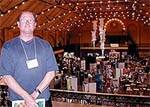
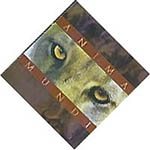
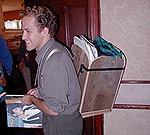

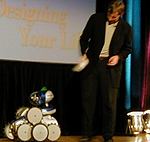




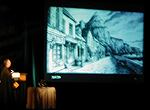
|



